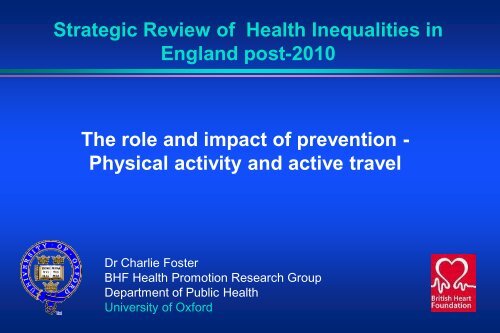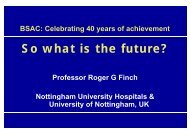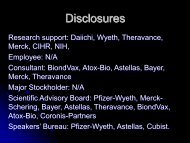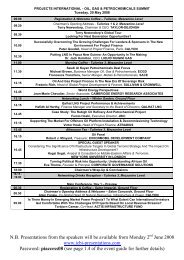Physical activity and active travel
Physical activity and active travel
Physical activity and active travel
You also want an ePaper? Increase the reach of your titles
YUMPU automatically turns print PDFs into web optimized ePapers that Google loves.
Strategic Review of Health Inequalities in<br />
Engl<strong>and</strong> post-2010<br />
The role <strong>and</strong> impact of prevention -<br />
<strong>Physical</strong> <strong>activity</strong> <strong>and</strong> <strong>active</strong> <strong>travel</strong><br />
Dr Charlie Foster<br />
BHF Health Promotion Research Group<br />
Department of Public Health<br />
University of Oxford
Presentation Objectives<br />
• To describe the case for physical <strong>activity</strong> <strong>and</strong> <strong>active</strong> <strong>travel</strong><br />
• To assess their relationship with inequalities<br />
• To present examples of successful <strong>active</strong> <strong>travel</strong><br />
interventions
First clinical episodes* of CHD in male central<br />
London bus drivers <strong>and</strong> conductors aged 35-<br />
64, 1949-1950<br />
No. of<br />
cases<br />
Age st<strong>and</strong>ardised Rate<br />
per 1000 p.a.<br />
Drivers 80 2.7<br />
Conductors 31 1.9<br />
*Angina, MI, CHD mortality<br />
Morris et al, Lancet 1953
<strong>Physical</strong><br />
<strong>activity</strong>
<strong>Physical</strong><br />
<strong>activity</strong>
<strong>Physical</strong><br />
<strong>activity</strong>
<strong>Physical</strong><br />
<strong>activity</strong>
Leisure<br />
Work<br />
<strong>Physical</strong><br />
<strong>activity</strong><br />
Exercise & Sport<br />
Active Travel<br />
Household
61% of men <strong>and</strong> 71% of women do not meet the Chief Medical<br />
Officer’s minimum recommendations for physical <strong>activity</strong> in adults<br />
% <strong>active</strong><br />
Men<br />
Women<br />
Age
% <strong>active</strong><br />
Age
% <strong>active</strong><br />
Age
% <strong>active</strong><br />
Age
% <strong>active</strong><br />
Age
% <strong>active</strong><br />
Age
% <strong>active</strong><br />
Age
<strong>Physical</strong> <strong>activity</strong>, <strong>active</strong> <strong>travel</strong> <strong>and</strong> inequalities<br />
• <strong>Physical</strong> <strong>activity</strong> choices are socially patterned
Hours per week<br />
Mean hours per week of brisk/fast pace walking<br />
in Scotl<strong>and</strong> <strong>and</strong> Engl<strong>and</strong> by social class<br />
2.5<br />
2.0<br />
1.5<br />
1.0<br />
Scottish Women<br />
Scottish Men<br />
English Women<br />
English Men<br />
0.5<br />
0.0<br />
I & II III NonManual III Manual IV & V<br />
Dr Melvyn Hillsdon – University of Exeter
Walking trips, for transport, per person per year<br />
by household income<br />
Lowest real<br />
income<br />
Second<br />
level<br />
Third<br />
level<br />
Fourth<br />
level<br />
Highest real<br />
income<br />
Walk 307 275 239 218 208<br />
Car 224 325 458 537 602<br />
National Travel Survey, 2006<br />
Dr Melvyn Hillsdon – University of Exeter
<strong>Physical</strong> <strong>activity</strong>, <strong>active</strong> <strong>travel</strong> <strong>and</strong> inequalities<br />
• <strong>Physical</strong> <strong>activity</strong> choices are socially patterned<br />
• Individual approaches to promote physical <strong>activity</strong> have the<br />
potential to increase inequalities<br />
• Availability of physical <strong>activity</strong> facilities declines with level of<br />
area deprivation
Availability of physical <strong>activity</strong> facilities declines with<br />
level of area deprivation<br />
The density of exercise<br />
facilities by quintile of<br />
deprivation for the<br />
county of Kent in<br />
Southeast Engl<strong>and</strong>
<strong>Physical</strong> <strong>activity</strong>, <strong>active</strong> <strong>travel</strong> <strong>and</strong> inequalities<br />
• <strong>Physical</strong> <strong>activity</strong> choices are socially patterned<br />
• Individual approaches to promote physical <strong>activity</strong> have the<br />
potential to increase inequalities<br />
• Availability of physical <strong>activity</strong> facilities declines with level of<br />
area deprivation<br />
• Active <strong>travel</strong> interventions must contain environmental<br />
supports to sustain individual choice (i.e. public transport)
Policies<br />
Places<br />
People
Bruno Taylor's Playful Spaces
Right-h<strong>and</strong> turn lanes
Right of way over motorists
Linked traffic light system
Priority of bicycle lanes
Using the environment to promote <strong>active</strong> living<br />
• Successful <strong>active</strong> <strong>travel</strong> interventions blend changes to<br />
places, people <strong>and</strong> policies<br />
• European examples demonstrate what can be achieved<br />
in the long term<br />
• NICE <strong>Physical</strong> <strong>activity</strong> <strong>and</strong> Environment public health<br />
guidance offers direction
The Cycling Demonstration<br />
Towns programme<br />
• First phase: October 2005 –<br />
October 2008<br />
• All towns funded at approx<br />
£5 per head per year,<br />
matched by the local<br />
authority<br />
• Comprehensive evaluation
Annual growth rates: European cities <strong>and</strong> CDTs<br />
City<br />
Annual<br />
increase in<br />
cycling flows<br />
Darlington +14.2%<br />
Exeter +9.9%<br />
Brighton & Hove +9.0%<br />
Strasbourg +7.0%<br />
Lanc w Morecambe +6.2%<br />
Vienna +6.4%<br />
Graz +5.9%<br />
Munich +5.5%<br />
Hanover +5.4%<br />
City<br />
Annual<br />
increase in<br />
cycling flows<br />
Nottingham +4.8%<br />
Freiburg +4.4%<br />
Munster +3.6%<br />
Aylesbury +3.6%<br />
Berlin +3.2%<br />
Derby +2.5%<br />
Zurich +2.3%<br />
Delft +1.2%<br />
Adapted from: Transport for London (2004) ‘Creating a chain reaction. The London Cycling Action Plan. February 2004.<br />
(http://www.croydon-lcc.org.uk/downloads/2004_TfL_LondonCyclingActionPlan.pdf)
Summary<br />
• <strong>Physical</strong> <strong>activity</strong> <strong>and</strong> <strong>active</strong> <strong>travel</strong> promotion are part of complex<br />
system approaches not isolated as single dose solutions<br />
• Synergies with economic regeneration, crime, welfare <strong>and</strong> climate<br />
change<br />
• We need high level strategic <strong>and</strong> political commitment, consistent<br />
implementation of best practice <strong>and</strong> targeted investment
Strategic Review of Health Inequalities in Engl<strong>and</strong> post-2010<br />
Thanks<br />
Nick Cavill – Cycle Engl<strong>and</strong><br />
Dr Melvyn Hillsdon – University of Exeter<br />
Dr Adrian Davis - Bristol City Council<br />
Phil Insall - Sustrans<br />
charlie.foster@dphpc.ox.ac.uk








